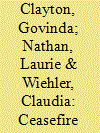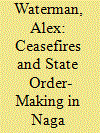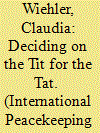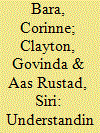|
|
|
Sort Order |
|
|
|
Items / Page
|
|
|
|
|
|
|
| Srl | Item |
| 1 |
ID:
178371


|
|
|
|
|
| Summary/Abstract |
Ceasefires are part of most contemporary peace processes, however empirical insight suggests that the characteristics of ceasefires vary greatly across conflict settings. This paper contributes to filling a research and knowledge gap about how different types of ceasefire come about through a comparative case study of ceasefires in the Moro and communist insurgencies in the Philippines. I argue that to understand differences in the characteristics of the ceasefires in these conflicts, it is important to consider the aims, ideologies and strategies of the conflicting parties and how this shapes their approach to a ceasefire. Following this, I suggest that ceasefires must be analyzed and understood with sensitivity to conflict issues and approaches to violence, as this contributes to an explanation of how ceasefire is used as a political tool and how it shapes the dynamics of conflict. Based on interviews and document studies, the article maps the characteristics of ceasefires in both cases over time and analyses the approaches to ceasefires of the parties to the conflict. Knowledge of how ceasefires come about and what shapes them can help both academia and policymakers draw more informed and accurate conclusions about their outcomes and effects.
|
|
|
|
|
|
|
|
|
|
|
|
|
|
|
|
| 2 |
ID:
178370


|
|
|
|
|
| Summary/Abstract |
The causes and consequences of ceasefires have become a burgeoning area of research. The concept of ceasefire success is integral to this research and plays a key role as either the dependent or independent variable in both qualitative and quantitative work. Despite its importance, it is not clear how ceasefire success should be conceptualized. This critically hampers the progress of theoretical and empirical research on ceasefires. This article offers a conceptual framework based on the central proposition that ceasefire success should be assessed in terms of two inter-related but conceptually distinct criteria: the immediate objective and the underlying purpose. The immediate objective, which is embedded in the definition of a ceasefire, is the cessation of hostilities (either permanently or temporarily). While all ceasefires share this objective, their underlying purpose, which is the reason for establishing the ceasefire, varies widely across cases. The immediate objective and the purpose, while conceptually distinct, are linked since the purpose informs the temporal and geographic scope of the cessation of hostilities. Based on this framework, we argue that researchers interested in ceasefire success need to clearly identify their assumptions and conceptual choices, which should take account of the political context of the ceasefires in question.
|
|
|
|
|
|
|
|
|
|
|
|
|
|
|
|
| 3 |
ID:
178376


|
|
|
|
|
| Summary/Abstract |
The 1997 Indo–Naga ceasefire is one of the world’s longest truces. Although formally-agreed rules technically regulate the state-rebel relationship, the rules themselves and their applicability beyond the Indian state of Nagaland are ambiguous and open to interpretation. Far from static, the ceasefire represents an evolving cluster of ‘armed orders’ oscillating between coexistence and limited conflict [Staniland, Paul. “Armed Politics and the Study of Intrastate Conflict,” Journal of Peace Research 54, no. 4 (July 1, 2017): 459–67. doi:10.1177/0022343317698848]. Indian state actors display intriguing variations in their approaches towards these orders, from restraint and de-escalation in some circumstances to aggressive local counterinsurgency in others. To date, however, existing research on order within ceasefires focus on rebel perspectives. Building on existing efforts to reconceptualise ceasefires as arenas in which political order is negotiated and constructed, this article re-introduces the state’s role in order-making, locating these processes within wider rebel and non-state attempts to do so. Analysing armed orders in the Naga ceasefire, it reveals a fascinating spectrum of bargaining, signalling and negotiation over the formal and informal rules of armed orders. This challenges the notion that ceasefires simply lock in state-armed group orders, but instead create new spaces for armed order’s renegotiation.
|
|
|
|
|
|
|
|
|
|
|
|
|
|
|
|
| 4 |
ID:
178373


|
|
|
|
|
| Summary/Abstract |
Ceasefires are agreed in most intra-state conflicts and the majority of these agreements are violated. Yet, the subsequent dynamics of retaliation are still poorly understood. This article proposes a novel conceptual framework, describing the decision-making of conflict parties after ceasefire violations. I argue that the conflict parties face the two-fold decision-making problem of choosing a proportionate reaction: a reaction that assures their interest in the ongoing conflict and in the continuation of the agreement. When proportionate reactions are chosen, mutual compliance with the ceasefire can be re-established. The empirical implications of this framework are illustrated with evidence from two ceasefires in the Mindanao conflict in the Philippines. This article advances our analytical understanding of an overlooked period during armed conflict, i.e. while a ceasefire is in place. This is critical since collapsing ceasefires can lead to a deterioration of the humanitarian situation and of the prospects for peace. More generally, this article draws the attention to the counter-intuitive function of violence to secure cooperation in intra-state conflicts.
|
|
|
|
|
|
|
|
|
|
|
|
|
|
|
|
| 5 |
ID:
178375


|
|
|
|
|
| Summary/Abstract |
In search of innovative solutions to address the growing complexity of civil wars, peacebuilding practitioners and conflict analysts have seriously begun exploring ways to involve national civil society actors in monitoring ceasefires. In contrast, the academic literature on the subject so far is surprisingly scarce and focuses mainly on the role of external third parties. This article argues that involving civil society in ceasefire monitoring mechanisms supports peace processes through four pathways: exposing noncompliance to ceasefire commitments; facilitating communication within and between conflict parties; promoting peace process issues among conflict parties; and socializing outside spoilers and raising public awareness about ceasefires. Based on a case study of the civil society-led National Monitoring Committee for the Ceasefire Code of Conduct (NMCC) appointed in the May 2006 ceasefire between the government of Nepal and Maoist rebels, the article shows that ceasefire monitoring by civil society can effectively prevent major ceasefire violations and support the parties’ transition to a peace agreement through the four pathways. The article also stresses that the NMCC faced commonly encountered constraints related to a lack of perceived impartiality, resources and diversity. It concludes that there is scope for a better operationalization of ceasefire monitoring mechanisms.
|
|
|
|
|
|
|
|
|
|
|
|
|
|
|
|
| 6 |
ID:
178372


|
|
|
|
|
| Summary/Abstract |
Policymakers and scholars generally assume that, unlike in interstate wars, in civil conflicts opposing forces cannot simply ‘agree to disagree:’ in order to stop fighting, one side must collapse, disarm, or concede. I argue that this assumption largely holds for centre-seeking conflicts, but not for separatist conflicts. Because separatist conflicts involve more geographically contained fighting and more limited stakes, rebels and states can more easily transition into cooperation. To test this argument, I create an original worldwide dataset of long-term truces in civil conflicts (1989–2015). That is, cases in which governments and rebels transition from open fighting to peaceful cooperation for an extended period without either side collapsing, disarming, or conceding. Overall, I find strong support for the main contention: while such truces are exceedingly rare in centre-seeking conflicts, they have happened in more than one-third of separatist conflicts since 1989. Even where rebels are strong or have little public support, separatist aims open space for containment and cooperation. These findings help fill in the empirical gaps between war and peace and document cases of peaceful cooperation without disarmament or political reform. They also highlight key differences between peacebuilding in centre-seeking and in separatist conflicts.
|
|
|
|
|
|
|
|
|
|
|
|
|
|
|
|
| 7 |
ID:
178369


|
|
|
|
|
| Summary/Abstract |
Ceasefires are arrangements in which conflict parties commit to temporary or permanent cessation of violence.
|
|
|
|
|
|
|
|
|
|
|
|
|
|
|
|
| 8 |
ID:
178374


|
|
|
|
|
| Summary/Abstract |
In 2018, the Government of Yemen and the Houthis concluded the UN-mediated Stockholm Agreement in which they agreed on a ceasefire in Hodeidah to be overseen by a UN monitoring mission. As of 2020, the implementation of the ceasefire is stalled, and the humanitarian situation has not improved. The purpose of this article is to provide a descriptive analysis of the challenges that UNMHA monitors have faced in Yemen. The empirical analysis builds on the literature on ceasefires and monitoring missions and focuses on four key factors: agreement quality, changes in the operational environment, the monitoring mission’s relation to the mediator, and conflict parties’ commitment to the ceasefire. I apply a qualitative case-study method, reviewing primary and secondary sources and conducting interviews with monitoring officers and local Yemenis. I find that monitors’ ability to carry out their mandate was hampered by the quality of the agreement and conflict parties’ perception of bias. Second, I find that the Houthis, operating from a position of relative strength prevented monitors from carrying out their mandate. Findings from the Yemeni case are relevant for other monitoring missions that are deployed in ongoing violent contexts, such as Libya or Ukraine.
|
|
|
|
|
|
|
|
|
|
|
|
|
|
|
|
|
|
|
|
|